Taking an environmentally sensitive approach to pest management
Herbicide Drift: What to do?
Published: May 5, 2017
When your vines experience herbicide drift be responsive and follow a reasonable response plan but don't forget about using the incident as means to implement a proactive prevention plan.
Herbicide drift is off-site movement and can result in non-target plant injury. Off-site movement of herbicides can occur by volatilization or physical drift.
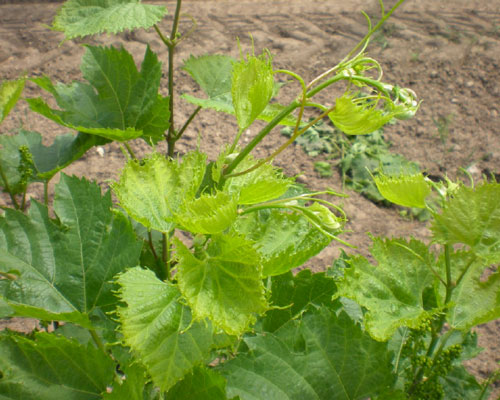
Common symptoms on grapevines of herbicide drift from growth regulating herbicides include; cupped leaves, downward bending of the shoots, yellowing of the leaves, and fingering of the leaf margins.
Volatilization is the conversion from a liquid or solid state to a gas or vapor state after the herbicide has been applied to the intended site. The herbicide in the gas or vapor phase may then move off-site and is affected by air temperature, wind speed, and moisture. Herbicides with high vapor pressures are considerably more volatile than herbicides with low vapor pressures. As an example, ester formulations of 2,4-D have higher vapor pressure and tend to volatilize more than amine formulations. The volatility can increase during hot dry weather.
Physical drift is the off-site movement of herbicide droplets prior to deposition at the intended site. Both environmental conditions and application equipment setup can play a role in physical drift. Wind speeds over 10 mph coupled with high temperatures and low humidity can cause spray droplets to evaporate quickly before deposition. These smaller herbicide-laden water droplets can then move from the intended site of application. Although spray equipment set-up is important and includes; nozzle selection, spray pressure, and boom height, physical drift can often be avoided if applications are avoided during high winds, low humidity, and high temperatures.
Reasonable Response to Herbicide Drift
Action Steps
- Document the damage using pictures and record the date the damage was first noticed. Also record the number of grape vines damaged, age of vines, and cultivars damaged. In addition document the phenology of when the damage occurred. For example, 3-inch shoots, 10-inch shoots, immediate pre-bloom, bloom etc.
- Try to identify the potential source of herbicide drift and types of herbicide(s). Be neighborly and try to resolve the problem without accusations. Remember that there are many potential sources of herbicide drift, including custom pesticide applicators, home owners, lawn care professionals, golf course managers, highway crews, etc.
- Contact the Missouri Department of Agriculture if you want to formalize a complaint. The Pesticide Incident Report should be filed within 30-days of when the damage was alleged to have occurred.
Daryl Slade
Pesticide Enforcement/Pesticide Use Complaints
573-751-5511
Missouri Department of Agriculture Enforcement and Inspections - Document the progression of the damage over time using pictures. Consider identifying 4 to 5 vines and identifying them with flagging tape and taking pictures on a weekly schedule. Try to take the pictures on the same day of the week to document the damage progressively.
- Document and record yield and continue to document damage the following season(s).
Auxiliary Step: For those that want to go the extra step and fully document what herbicide(s) may be causing the damage, the affected tissues can be screened for the presence of herbicides. Contact SGS Analytical Services for pricing and sample submission. If interested in this service be sure to collect a sample when symptoms first appear because over time the grape plant will metabolize the active ingredient into metabolites. I do not endorse this lab over any others.
Another Consideration. Also be aware that if a herbicide residue is found within a crop in which the product is not labelled that there is the potential that the crop may not be able to be harvested. For example, if 2,4-D resides are found within grape leaves that would be off label as 2,4-D is not labelled to be used in grapes. Even though the product was not applied but drifted onto the grape crop.
Proactive Prevention of Herbicide Drift
- Site selection is your best tool to avoid herbicide drift. Select a vineyard site that is not in close proximity to row-crop agriculture, or other areas where phenoxy herbicides are used regularly such as golf courses, right-of-ways, and housing subdivisions.
- Create awareness of your vineyard to neighbors and educate neighbors about the sensitivity of grape vines to phenoxy herbicides. Explain alternative practices that can reduce the potential of herbicide drift. For example, using 2,4-D amine instead of ester formulations of 2,4-D, applying phenoxy herbicides when the air temperature is below 80°F, using spray nozzles that increase droplet size such as air induction nozzles, applying pesticides when the wind speeds are 3 to 10 mph and the wind is not blowing towards the vineyard, and using appropriate sprayer boom height.
- Consider planting buffer zones of trees to limit drift into your vineyard. If planting trees for a buffer zone, do not plant trees that will limit cold air drainage.
- Register your vineyard on the Drift Watch website. This creates more awareness for your vineyard and also allows pesticide applicators to know the exact location. Many commercial applicators use the Drift Watch site to identify sensitive crop locations.
Herbicides Causing Grape Injury
Grapevines are sensitive to a number of herbicides. Many grape growers are familiar with the damage caused by 2,4-D. The herbicide 2,4-D is classified as a phenoxy herbicide. There are a number of herbicides that can cause similar symptomology as 2,4-D on grapes. All of these herbicides are classified as auxin growth regulators (Table 1).
Table 1 Common auxin growth regulator herbicides that can cause injury to grape vines.
Herbicide Class |
Common name |
Active ingredient |
Trade name |
Phenoxyacetic |
2,4-D |
Dimethylamine salt of 2,4-dichlorophenoxyacetic acid |
2,4-D |
MCPA |
Dimethylamine salt of 2-methyl-4-chlorophenoxyacetic acid |
MCPA |
|
Benzoic Acids |
dicamba |
3,6-dichloro-2methoxybenzoic acid |
Banvel, Clarity |
Picilinic Acids (Pyridines) |
picloram |
4-amino-3,5,6-trichloropicolinic acid |
Tordon, Grazon1 |
clopyralid |
3,6-dichloro-2-pyridinecarboxylic acid |
Stinger, Transline |
|
triclopyr |
2,5,6-trichloro-2-pyridinyloxyacetic acid |
Crossbow2, Garlon |
1 Grazon is a premix and also contains 2,4-D.
2 Crossbow is a premix and also contains 2,4-D as a butoxyethyl ester.
Some of these herbicides are used in agricultural row-crops to control broadleaf weeds. However be aware that 2,4-D, MCPA, and dicamba are also available in premixes to control many broadleaf weeds in lawns or turf. The picolinic acids and pyridines that includes products containing picloram, clopyralid or triclopyr are often used to control woody vegetation in ditches, fence lines, right-of-ways, and grass pastures. All the herbicides listed in Table 1 have the potential to volatize and lift off the intended target site after application.
Although the growth regulator herbicides are often reported as causing injury to grapes there are also a number of other herbicides that can cause herbicide injury to grapevines. Glyphosate the active ingredient in a number of herbicides (Roundup Ultra, Weathermax, Touchdown etc.) can cause substantial damage to grapevines if it comes in contact with green tissue.
The Weathermax label specifically states to keep the spray mixture off green grape tissues such as leaves, shoots, suckers, and green trunks. Glyphosate is a systemic herbicide and is readily translocated to growing points in the roots and shoots causing cell death. A number of glyphosate containing products are used both in row-crop agriculture, right-of-ways, and by homeowners. Although glyphosate does not have the propensity to volatilize like the growth regulator herbicides, the spray mixture can move off-target if not applied in accordance with the label.
Not sure what herbicide may be causing the damage? Review this herbicide mode of action chart to narrow the possibilities.
Symptomology on grapevines from growth regulating herbicides
In the immediate future grape vineyards throughout the Eastern corn and soybean belt will likely be exposed to a very toxic combination of herbicides. Both Monsanto and Dow AgroSciences will be releasing corn and soybeans that are resistant to both glyphosate and phenoxy herbicides. The phenoxy herbicide resistance will be to dicamba in Monsanto's Xtend products and 2,4-D in Dow AgroSciences Enlist products.
Recognizing herbicide drift symptomology is the first step in diagnosing a potential drift incident. Although glyphosate combined with dicamba or 2,4-D is very damaging to grapevines, previous research has provided limited herbicide combination symptomology that has practical diagnostic application (AL-Khatib et al. 1993).
Current research by my colleagues and me documented herbicide symptomology using time lapse photography on greenhouse grown Norton grapevines to foliar applications of glyphosate, dicamba, 2,4-D, and the combinations of glyphosate + dicamba and glyphosate + 2,4-D. The herbicide rates applied represent 1/100 the recommended use rate of 2,4-D, dicamba, glyphosate, 2,4-D + glyphosate and dicamba + glyphosate. Additionally an untreated control. The rates applied were 0.01 lb/acre 2,4-D, 0.005 lb/acre dicamba, 0.01 lb/acre glyphosate, 0.01 lb/acre 2,4-D + 0.01 lb/acre glyphosate, 0.005 lb/acre dicamba + 0.01 lb glyphosate, and an untreated control. The experiment was conducted within greenhouses and time-lapse cameras took photographs every 10 minutes over a period of 21 days after treatment. Below are some selected time points showing the development of symptomology from 1/100 the recommended use rate of 2,4-D.
| hours after treatment | Untreated | 2,4-D |
| 3 |  |
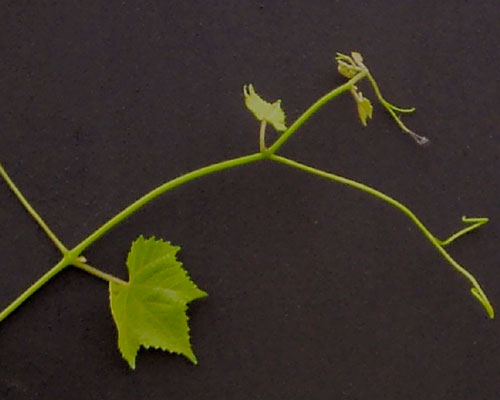 |
| 24 |  |
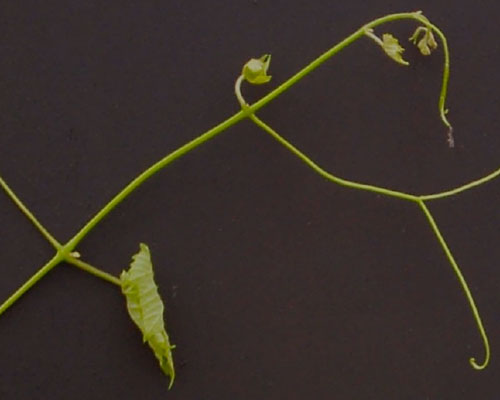 |
| 48 |  |
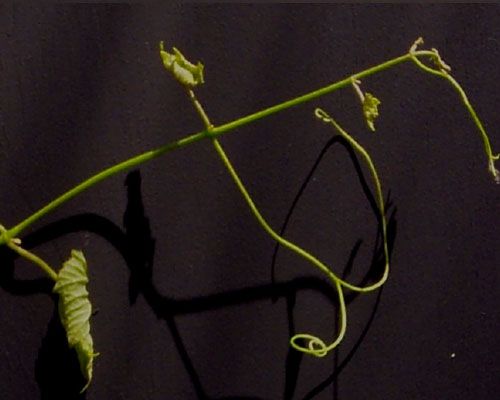 |
| 168 |  |
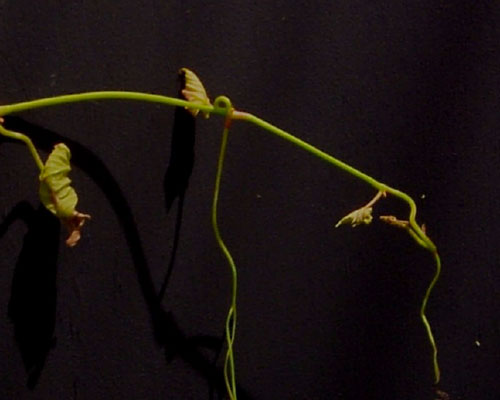 |
Herbicide damage symptomology on grapes caused by growth regulator herbicides such as 2,4-D.


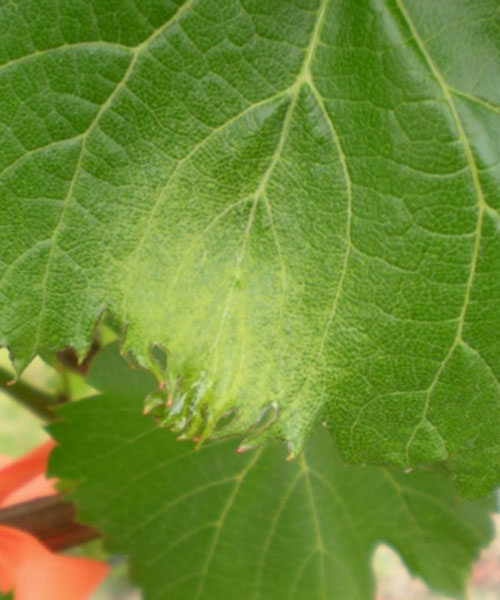
First, a fan shaped, chlorotic leaf and fingering of leaf margins, classic injury symptoms of growth regulator herbicides. Next, cupped leaves with fingering of the leaf margin caused by growth regulator herbicides. Last, a close up of fingering of the leaf margin. Note, compare to normal leaf margin.
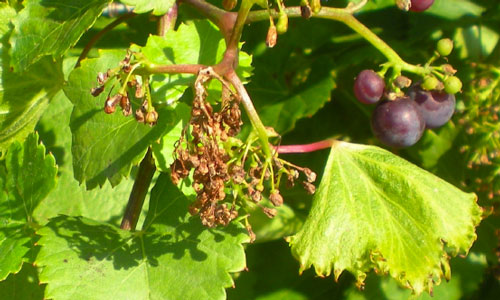
The grape vine pictured above was in a urban setting in which Weed-and-Feed had been applied to the lawn in the vineyard. The vines are showing all the classic symptoms of growth regulator herbicide injury that includes; chlorosis, fan shaped leaves, fingering of leaf margins, and flower abortion.
A look at other herbicides and their symptomology on grapes.

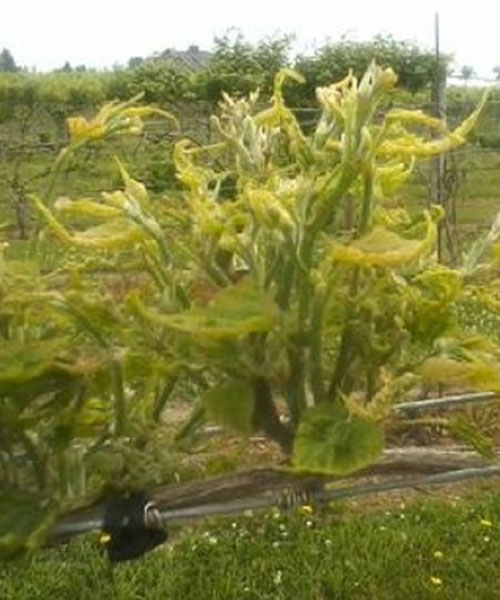
This vineyard received herbicide drift from a herbicide product containing the active ingredient glyphosate. The symptoms of glyphosate damage are stunted shoot growth, strapped leaves, chlorosis (as in the close up picture) and the following spring the vines typically will break multiple buds.
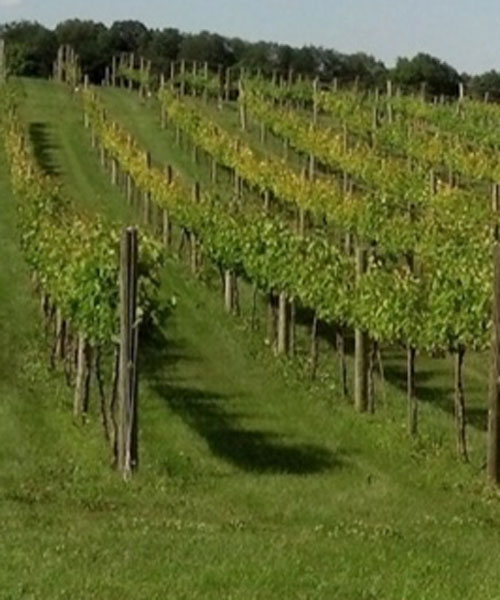

This vineyard received herbicide drift from two herbicide products; 2,4-D and mesiotrione. Mesiotrione is the active ingredient in Callisto herbicide. These herbicides are classified as "bleachers" and inhibit an enzyme involved in carotene synthesis. This results in chlorophyll not being protected from sunlight and the chlorophyll breaks down. In the close up image, chlorophyll has broken down and anthocyanin pigments are seen in the red coloration of the leaves.
Subscribe to receive similar articles sent directly to your inbox!
- Mitigation of Herbicide Injury with Windbreaks (08/01/22)
- Crucial Period of Disease Management in Grapes (06/07/22)
- Managing Sour Rot of Wine Grapes in Missouri (11/17/20)
REVISED: February 21, 2017